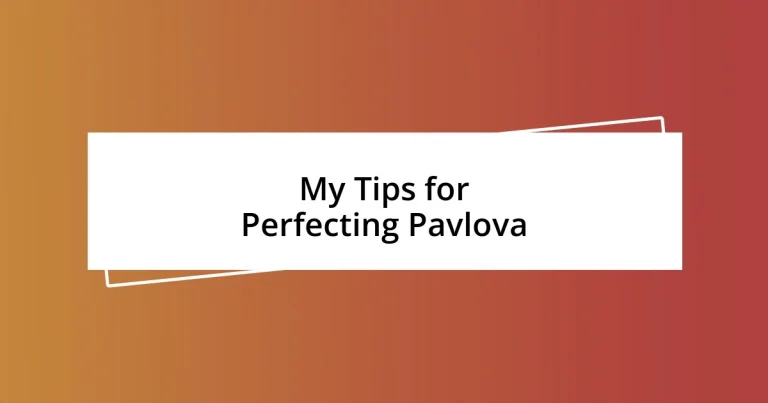Key takeaways:
- Pavlova is a meringue-based dessert requiring precision in technique, particularly in whipping egg whites and ensuring a clean, grease-free environment.
- Choosing the right ingredients, especially superfine sugar, is crucial for achieving the desired texture and stability in Pavlova.
- Common issues like sogginess, cracking, and collapsing can be resolved through careful handling, proper baking temperature, and maintaining a clean workspace.

Understanding Pavlova Basics
Pavlova is a delightful meringue-based dessert with a crisp outer shell and a soft, marshmallow-like interior. My first attempt at making Pavlova was a mix of excitement and anxiety; I still remember the sweet aroma wafting through my kitchen as I whipped the egg whites to perfect peaks. Have you ever felt that rush of anticipation while baking something special?
At its core, Pavlova relies on just a few ingredients—egg whites, sugar, vinegar, and cornstarch—which may sound simple, but the magic lies within the technique. I learned that the perfect meringue is all about patience and gentle handling; too much mixing can deflate that heavenly airiness. Isn’t it fascinating how such a delicate balance can create something truly spectacular?
The origins of Pavlova are often debated between Australia and New Zealand, adding a playful rivalry to its already charming story. I’ve often found myself drawn to the anecdotal history of Pavlova, imagining the great dancers who inspired its creation. Have you thought about how a dessert can carry both tradition and artistry? It’s that blend of simplicity and elegance that makes Pavlova a true showstopper.

Essential Ingredients for Pavlova
To achieve that delightful texture and flavor in Pavlova, you’ll need to gather a few essential ingredients. The quality of these components can truly make or break your dessert, so I always opt for fresh, high-quality items. When I first experimented with different sugars, I discovered that superfine sugar dissolves more easily, resulting in a smoother meringue. It’s these little tweaks that elevate your Pavlova from good to unforgettable.
Here’s a quick rundown of the crucial ingredients:
- Egg Whites: The backbone of your meringue; make sure they’re at room temperature for the best results.
- Superfine Sugar: This dissolves quickly, contributing to a glossy finish and stable structure.
- Vinegar: A splash of white vinegar helps create that marshmallowy interior and offers a slight tang.
- Cornstarch: This provides stability while ensuring that unique chewy center, balancing out the crisp outer shell.
I still recall the first time I made Pavlova with a touch of lemon juice instead of vinegar—what a difference! It added a refreshing hint that made every bite sing. Each ingredient plays a significant role, so don’t underestimate their power in crafting this delightful dessert.

Mastering the Egg Whites Technique
Mastering the egg whites technique is crucial for achieving that perfect Pavlova. When I first started, I was surprised at how much of a difference the whipping method made. It’s all about getting those egg whites to the right consistency. For instance, I found that using a clean, grease-free bowl is essential. Any fat can hinder the whipping process, leading to disappointing results. Have you ever experienced that frustrating moment when your egg whites just won’t whip up?
As you whip the egg whites, pay attention to how they transform. The moment they turn from cloudy to glossy is pure magic. I vividly remember the first time I witnessed that transformation; I felt like a true pastry chef! Gradually adding sugar while the mixer runs is key, as it ensures a smooth, stable meringue. I recommend adding the sugar slowly, about one tablespoon at a time, giving it time to dissolve fully. It’s those little steps that make all the difference!
The final stage is achieving stiff peaks. When you lift the whisk, the peaks should stand tall and firm. I still get excited every time I reach that stage. It’s that moment of pride, knowing you’ve nailed the egg whites! The precise technique can seem daunting, but the reward is that ethereal texture that makes Pavlova a delight on any dessert table.
| Technique | Description |
|---|---|
| Whipping Egg Whites | Whip egg whites until frothy and begin adding sugar gradually for stability. |
| Avoiding Grease | Ensure bowls and utensils are completely clean to achieve volume. |
| Stiff Peaks | Egg whites should hold peaks without drooping for best results in meringue. |

Choosing the Right Sugar Type
When it comes to making Pavlova, the type of sugar you choose can significantly affect your final product. My go-to is always superfine sugar. I remember the first time I experimented with granulated sugar instead; the texture of my meringue was grainy, and not at all the light, airy dream I was hoping for. By the time I switched to superfine, it felt like a revelation—the smoother texture made such a difference, creating a Pavlova that was not just good but absolutely sublime.
Another option I’ve tried is powdered sugar. It can lend an even more delicate consistency, but I found it can also add extra cornstarch, which I suspect might not sit well with everyone’s palate. Have you ever tasted a Pavlova that felt too sweet? I have. It’s in those moments I realized that less can be more when it comes to sugar. Each variety brings something unique, which is why it’s so important to experiment and find what resonates with you.
Lastly, don’t forget about the role sugar plays in stability. I often wondered why my earlier attempts at Pavlova didn’t hold their shape. It was only after I switched my sugar type and began measuring carefully that I learned the impact of the right sugar on not just flavor but structure as well. Choosing the right sugar isn’t merely a matter of taste; it’s an integral part of mastering that perfect Pavlova.

Creative Toppings for Pavlova
When it comes to toppings for Pavlova, the possibilities are as endless as your imagination. One of my all-time favorites is a vibrant mix of fresh berries. I’ll never forget the first time I piled ripe strawberries, blueberries, and raspberries on top; the explosion of color and tartness was truly delightful. Have you ever tasted that balance of sweetness from the meringue and the zing from the berries? It creates a harmony that’s simply irresistible.
Another creative topping I love is coconut cream with toasted coconut flakes. There’s something magical about that combination—the creamy texture of the coconut cream sets off the crispiness of the Pavlova perfectly. I distinctly recall an evening where I served that twist at a dinner party, and my friends couldn’t stop raving about it. It felt great to delight their taste buds with something that hadn’t crossed their minds before!
If you’re feeling adventurous, consider adding a drizzle of passion fruit curd. That tangy, luscious flavor elevates the Pavlova to a whole new level. I tried it once on a whim, and the reaction was priceless—everyone asked for seconds! The best part about experimenting with toppings is discovering what blends beautifully. Remember, the options are not just about taste; they add a touch of personality to your dessert. What unique combination do you think would wow your guests?

Troubleshooting Common Pavlova Issues
When it comes to troubleshooting baking, Pavlova can throw some surprises your way. I vividly recall my first attempt when the outer crust turned out soggy instead of crisp. It was a frustrating moment, but after some research and a few trials, I learned that ensuring my oven was properly calibrated and setting it to a low temperature to dry out the meringue truly made a difference. Have you ever experienced that disappointing texture? Trust me, the right temperature is your best friend!
Another common issue I’ve faced is the dreaded cracking. I remember pulling my Pavlova out of the oven, only to find a fissure running through the center like a fault line. It turned out that gentle handling while folding in the egg whites was crucial. By being more cautious and mixing slowly, I began to see success! It’s amazing what a little patience can achieve in baking, don’t you think?
Lastly, if your Pavlova collapses or weeps, don’t be discouraged. I once had a delightful meringue transform into a puddle of sugary sadness, which was disheartening. However, I discovered that ensuring my bowl and utensils were completely grease-free and that I didn’t underbake the meringue helped create a stable structure. It’s those little details that truly matter, and trust me, learning from these blunders only makes your next Pavlova even sweeter.














